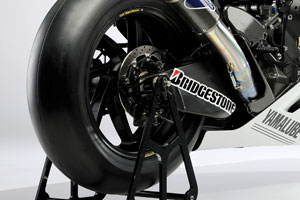Tyres are one of the most important parts of your motorcycle. We look at the best ways to scrub them in and warm them up for the track and road.

RACE TYRES
For those riders who are looking to go to the next level and have purchased a track bike for circuit use only, there’s a good chance you’re going to be looking at fitting race tyres — whether they’re slicks or race spec treaded tyres.
It’s more important when using race tyres that you do use tyre warmers, which helps the tyres heat up quicker and more safely (race tyres take longer to heat up for most brands).
Race tyres (especially slicks) feel stiffer when on the bike, offering slightly less feel until you ride that little bit faster and this is when you really begin to realise the benefits.
Another important thing to remember is that most race tyres don’t have sufficient tread for wet weather, so it’s important to also have a set of wet weather tyres ready to go if it looks like it could rain that day.
Some brands allow you to get away with it in the wet, although it’s better to be safe than sorry.
Some of the most commonly asked questions that I receive at our Road Race Performance Academy schools are usually about tyres — what brand is the best, how many track days should you do on a set of tyres, what’s the ideal compromise between track and street use, and so on.
But the answers are always ranging depending on the bikes and the particular style of each and every rider. To quickly answer the questions set out above, the brand of tyre that you use is usually a personal choice.
Tyres that are softer and offer more grip will usually wear faster, while harder compound tyres will last for an extra day or more, but won’t exactly offer the confidence that a softer tyre would.
For information regarding what tyre may suit you best and to find out what tyres are harder or softer, the ideal way is to check through your dealer or even search on the internet as there are quite a few real world experiences written about in stories or on chat forums, etc.
The answer to how many track days can you get out of a set of tyres is a tricky one — I usually get around two days on street-spec tyres, while I’ve also seen some guys get up to seven because they are simply not going fast enough to wear them quickly.
As for the ideal compromise between road and track, if you’re a track junkie who only occasionally gets the bike out for a weekend ride on the public roads, it’s probably best to go for softer tyres and gain confidence on the circuit.
On the other hand, if you use your bike to commute to and from work and only visit the race track a couple of times a year, you really could get away with a set of harder sport-touring tyres that are going to offer optimum mileage on the road.
Once you have selected your tyres of choice, you’re going to have to scrub them in before you can ride at the level and speed that you could on your previously used tyres.
The best way to scrub in a tyre is to ride at a slower pace for a session or two on the track (or around an hour on the street), ensuring that you gradually increase lean angles as the tyre heats up and begins to increase grip.
This will help you safely bed in the tyre before you begin to ride at a normal speed and style, allowing the tyre to do its job and offer maximum adhesion to the tarmac.
You often see racers weaving from side to side before the start of the race to scrub in the tyres quicker, although this method isn’t 100 percent consistent and rarely enables the tyre to get used all the way to the sidewall.
Some people believe that weaving will actually increase heat in the tyre right before the race, although this is an old myth that’s been proven not to be true.
In fact, the best way to build heat in the tyre is to accelerate and brake while you are upright (make sure you have plenty of room around you so you don’t cause an accident), much like you see the drivers do in Formula One car racing.
This style makes the tyre flex far more than weaving, which generates heat much more efficiently than anything else early on in a ride when the tyres are still too slippery to hold full lean angle or carry your usual speed.
If you’re right into track days, it’s a great idea to invest in a set of tyre warmers, which will allow you to ride straight out of the pits and have your tyres up to temperature.
Tyre warmers not only allow you to make the most of every session because you can go fast from the very first lap, but also increase the life of your tyres as the possibility of cold tearing is decreased.
It’s a good idea to get your warmers on the bike for around 45 minutes to an hour (depending on your tyres and the temperature of the day) before you ride, allowing the heat to truly set in to both the tyres and even the wheels.
So after all this, how do you know that the tyre you have chosen is truly the one for you? Well, the best bet is to experiment for at least your first few sets of tyres and feel the different characteristics for yourself.
Once you’ve done plenty of mileage on a few different brands of tyres, select the one that felt best and be confident that it’s the right choice for you. Tyres are what connects you and your bike to the tarmac, so it’s critical to find a confidence inspiring tyre that will allow you to ride exactly how you want to.






